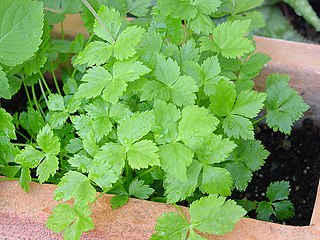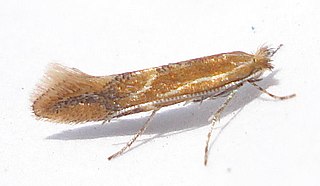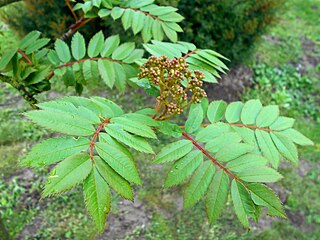Related Research Articles

Rosaceae, the rose family, is a medium-sized family of flowering plants that includes 4,828 known species in 91 genera.

Cryptomeria is a monotypic genus of conifer in the cypress family Cupressaceae, formerly belonging to the family Taxodiaceae. It includes only one species, Cryptomeria japonica. It used to be considered by some to be endemic to Japan, where it is known as Sugi. The tree is called Japanese cedar or Japanese redwood in English. It has been extensively introduced and cultivated for wood production on the Azores.

Psyllidae, the jumping plant lice or psyllids, are a family of small plant-feeding insects that tend to be very host-specific, i.e. each plant-louse species only feeds on one plant species (monophagous) or feeds on a few closely related plants (oligophagous). Together with aphids, phylloxerans, scale insects and whiteflies, they form the group called Sternorrhyncha, which is considered to be the most "primitive" group within the true bugs (Hemiptera). They have traditionally been considered a single family, Psyllidae, but recent classifications divide the group into a total of seven families; the present restricted definition still includes more than 70 genera in the Psyllidae. Psyllid fossils have been found from the Early Permian before the flowering plants evolved. The explosive diversification of the flowering plants in the Cretaceous was paralleled by a massive diversification of associated insects, and many of the morphological and metabolic characters that the flowering plants exhibit may have evolved as defenses against herbivorous insects.

Camellia japonica, known as common camellia, or Japanese camellia, is a species of Camellia, a flowering plant genus in the family Theaceae. There are thousands of cultivars of C. japonica in cultivation, with many colors and forms of flowers. Despite its common name, it is native to China, not Japan. The cultivation of Camellia japonica also started in China. Its widespread cultivation can be traced back to the Song Dynasty, when 15 varieties of Camellia japonica were recorded in literature. It was later introduced to Japan. It grows in forests, at altitudes of around 300–1,100 metres (980–3,600 ft).

Cryptotaenia, or honewort, is a genus of herbaceous perennial plants, native to North America, Africa, and eastern Asia, growing wild in moist, shady places.

Caenorhabditis is a genus of nematodes which live in bacteria-rich environments like compost piles, decaying dead animals and rotting fruit. The name comes from Greek: caeno- ; rhabditis = rod-like. In 1900, Maupas initially named the species Rhabditis elegans, Osche placed it in the subgenus Caenorhabditis in 1952, and in 1955, Dougherty raised Caenorhabditis to the status of genus.

Panonychus ulmi, the European red mite, is a species of mite which is a major agricultural pest of fruit trees. It has a high reproductive rate, a short generation time and produces many broods in a year, all of which contribute to its pest status. It has a cosmopolitan distribution, and a very wide host range, having been found on the following plants:

Psylla pyri, commonly known as the pear psylla or pear psyllid, is an insect in the family Psyllidae. Originating in Europe and Asia, it has spread to North America. It is a pest of pear trees, sucking the sap, damaging the foliage, flowers and fruit and diminishing the crop.

Cacopsylla melanoneura is an insect of the Psyllidae family. It mainly feeds on Hawthorn. The insect will also feed on apple trees and is considered the main vector of the phytoplasma disease "Ca. Phytoplasma mali" in northwestern Italy.

Phyllonorycter corylifoliella, the hawthorn red midget moth, is a moth of the family Gracillariidae. It is found in all of Europe.
Phyllonorycter crataegella, the apple blotch leafminer, is a moth of the family Gracillariidae. It is known from Canada the United States.

Psylla is a genus of sap-sucking insects belonging to the order Hemiptera. There are at least 110 described species in Psylla. Species within the genus feed on various host plants.
Caenorhabditis japonica is a species of nematodes in the genus Caenorhabditis. Its genome was sequenced by the McDonnell Genome Institute at Washington University School of Medicine. This gonochoristic species is found in the 'Japonica' group, the sister clade to the 'Elegans' group, in the 'Elegans' supergroup.

Cacopsylla is a genus of bugs in the Psyllidae family, the jumping plant lice. The genus includes most of the psylla harmful to fruit trees. They can be referred to by the common name 'pear psyllids', as they can only develop on plants of the genus Pyrus.

Anthocoris nemoralis is a true bug in the family Anthocoridae. The species is native to Europe and is introduced in North America. It is a predator of aphids, spider mites and jumping plant lice, and is therefore used as a biological pest control agent.

Cacopsylla ulmi is an insect of the Psyllidae family. It mainly feeds on Elm. Cacopsylla ulmi is a widespread species in Europe, including Britain and the Balkans. Adults are 3.6–4.3 mm long. The head is 1–1.01 mm wide, with a vertex which is 0.5 mm wide and 0.24–0.28 mm long. The genal cones are laterally somewhat concave, and 0.25 mm long. Antennae are 1.89–2.0 mm. Forewings are 3.5 mm long and 1.4 mm wide.

Psyllinae is a subfamily of plant-parasitic hemipterans in the family Psyllidae. There are about 12 genera and at least 40 described species in Psyllinae.
Cacopsylla pyricola, commonly known as the pear sucker, is a true bug in the family Psyllidae and is a pest of pear trees (Pyrus). It originated in Europe, was introduced to the United States in the early nineteenth century and spread across the country in the next century.

Cacopsylla mali is a species of insect belonging to the family Psyllidae.

Sorbus discolor is a species of flowering plant in the family Rosaceae, native to China. Although it is recorded in wide use as an ornamental tree in the United Kingdom and other countries, Some European specimens labelled as Sorbus discolor have been found instead to be misidentified examples of Sorbus commixta, the Japanese rowan. Sorbus commixta fruit is bright orange to red, whereas the fruit of Sorbus discolor is white, or possibly dull pink to yellowish-orange.
References
- 1 2 Inoue, Hiromitsu (December 2004). "Descriptions of two new and one little known species of the genus Cacopsylla (Hemiptera: Psyllidae) on Sorbus japonica (Rosaceae) and an observation of their biology". Entomological Science. 7 (4): 399–413. doi:10.1111/j.1479-8298.2004.00089.x.